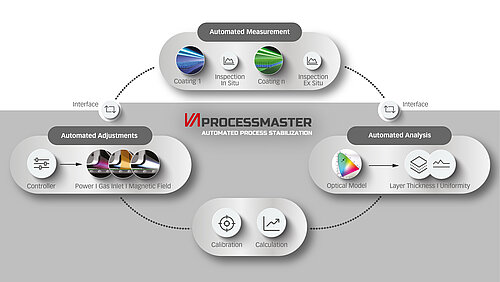Heat and sun protection coatings for architectural glass are one of the most important achievements for the energy efficiency of economies in the last 40 years. Thanks to selective layer systems, the heat loss through windows in buildings with large glass facades can be reduced fivefold compared to single glazing. The heat intake can be reduced by solar control coatings, which makes it possible to use much smaller air conditioning systems and to save energy for cooling.
A very similar coating technology is now penetrating the automotive glass market. In this field, the goal is to reduce the energy intake in the interior of vehicles through the windshield and sunroofs. This helps reduce the energy consumption of air conditioning systems and enables a larger range for electric vehicles.
The basic technology for making energy-efficient optical coatings for architectural and automotive glass was developed more than 40 years ago. But today, new digital technologies in automation and communication take energy efficiency to a new level. This is not limited to the final product but is especially true for the production process itself.
The German company VON ARDENNE has been a leading provider of coating equipment in this market for decades. For three years, it has bundled digital products for process automation and other digital services under the brand VA INDIGO.
“A central motivation for developing these software products is the efficient use of the necessary resources” said Anja Kalesse, the responsible product manager for the digital solutions. “For the first time in large-area coating, we have developed a solution for the monitoring and control of not just single processes, but of complete optical layer stacks”, she pointed out. This solution is called VA PROCESSMASTER and stabilizes the coating result. It is a set of tools for the operator of a machine that ensures the stability of the production of the optical coatings and that changes to production parameters can happen smoothly. But the best of it is: The necessary hardware for running this software is already in place in many glass coating systems.
As a result, the glass manufacturers create less scrap, even with rather complex coated glass panes such as façade glass and windshields for vehicles. As a result, they waste less material and save energy, as fewer glass panes need to be melted down again.
Algorithms that define and monitor the optimal working point of the sputtering process also help save energy. If the desired coating rate can be achieved with a minimum of the necessary energy, this lowers the energy consumption of the equipment, the peak load and therefore the overall production costs. To ensure that, VON ARDENNE has developed a software product called VA TIPCOS, which is already in operation.
“As a next step, we will automate, and therefore simplify, the process control with a comprehensive and high-performance recipe architecture.” said Anja Kalesse. According to her, the VA RECIPEMASTER will make it possible to automate ramp-ups and switching between different procedures in production. As a result, the production will be less and less reliant on the expertise of certain experienced individuals. Instead, best-practice procedures will be translated into stable algorithms that will run consistently in a reliable way.
Thus, the production will be simplified and protected against human failure. If the operators of coating systems can rely on automation for an increasing number of procedures, this will also reduce the number of variables for them during troubleshooting. They will identify the cause for an issue much faster because they can immediately rule out a multitude of possible error sources. That means that the coating system will be operational in a much shorter time. And this will in turn increase the productivity and the efficiency of the used resources.
With the help of other digital tools, such as AR smart glasses, service technicians or engineers can support customers in real time with their expert knowledge. In this way, they can ensure the optimal utilization of the production equipment without long-distance travelling and accommodation. In the future, there will be less and less need to stop the coating system for maintenance. And the fewer ramp-ups and ramp-downs will also lead to energy savings and less emissions of greenhouse gases.
Of course, these are only some examples of tools and innovations that can contribute to saving energy in glass processing. For the first time after a longer break due to the Corona crisis, VON ARDENNE will exhibit at the glasstec in Düsseldorf, Germany, in September this year. At this major event for the glass industry, the company will present the solutions described above and discuss the ones that are emerging.

